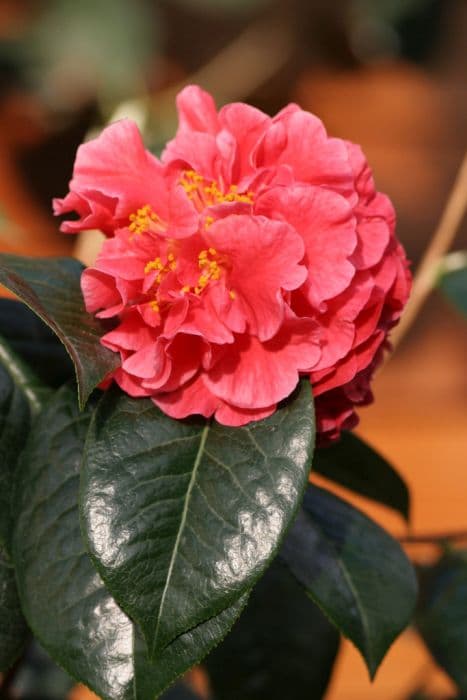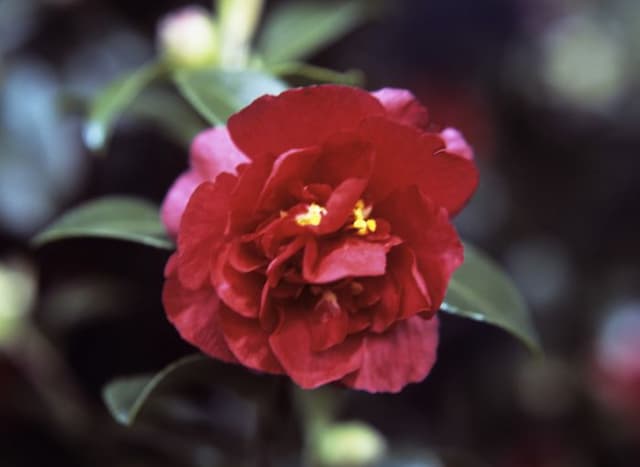Japanese Camellia Camellia japonica 'Mathotiana Rosea'

ABOUT
Camellia japonica 'Mathotiana Rosea', commonly known as the Rose of Winter, is admired for its splendid flowers that bloom in the cooler months, typically from winter through early spring. This particular variety is well-loved for its large, rose-pink flowers that boast a formal, double form—meaning the petals are arranged in several rows, giving them a full and rounded appearance reminiscent of classic roses. The blooms, which can be quite striking, often feature a slight variation in pink shades, with the inner petals sometimes being a touch darker or having a deep pink hue at the edges, creating a beautiful depth and contrast within each flower. The petals themselves are broad and can have a subtle, velvety texture that enhances the plant's luxurious feel. Beneath the showy blossoms, the foliage forms a lush backdrop of glossy, dark green leaves. The leaves have a leather-like quality with a smooth, almost polished surface and serrated edges. Their elongated oval shape tapers to a point, and the rich, evergreen color of the leaves provides year-round interest, creating a lovely contrast to the soft pinks of the flowers. The plant has a naturally elegant habit, usually presenting itself with a symmetrical and well-branched structure. The overall appearance of the Rose of Winter is one of classic beauty, making it a favored choice for gardeners seeking to add a touch of romance and color to their landscape during the cooler parts of the year.
About this plant
 Names
NamesFamily
Theaceae
Synonyms
Japanese Camellia, Rose of Winter, Tsubaki
Common names
Camellia japonica 'Mathotiana Rosea'.
 Toxicity
ToxicityTo humans
Camellia japonica, also known as Japanese camellia, is generally considered non-toxic to humans. There are no widely recognized symptoms of poisoning in people from ingesting any part of this plant.
To pets
Japanese camellia is also generally considered non-toxic to pets. Therefore, it is not typically associated with symptoms of poisoning in animals such as dogs and cats from ingesting any part of this plant.
 Characteristics
CharacteristicsLife cycle
Perennials
Foliage type
Evergreen
Color of leaves
Green
Flower color
Pink
Height
6-10 feet (1.8-3 meters)
Spread
6-10 feet (1.8-3 meters)
Plant type
Shrub
Hardiness zones
7
Native area
Japan
Benefits
 General Benefits
General Benefits- Ornamental Appeal: The Camellia japonica 'Mathotiana Rosea' adds aesthetic value to gardens with its attractive rose-pink flowers and glossy green foliage.
- Year-Round Interest: This evergreen shrub provides interest throughout the seasons, with blooms typically appearing in winter to spring, when few other plants flower.
- Habitat for Wildlife: It offers shelter and food to various species of birds and insects, thus enhancing biodiversity.
- Privacy Screen: With its dense growth habit, it can be used as a hedge or screen to provide privacy in residential landscapes.
- Soil Erosion Control: The extensive root system helps in stabilizing the soil and preventing erosion in sloped areas.
- Shade Tolerance: It is capable of growing in shaded areas where other plants might struggle to thrive, making it versatile for different garden settings.
- Low Maintenance: Once established, it requires minimal care, making it suitable for gardeners of all skill levels.
 Medical Properties
Medical PropertiesThis plant is not used for medical purposes.
 Air-purifying Qualities
Air-purifying QualitiesThis plant is not specifically known for air purifying qualities.
 Other Uses
Other Uses- Crafting natural dyes: The petals of Camellia japonica, commonly known as Japanese camellia, can be used to create delicate pink dyes for fabrics and art projects.
- Floral arrangements: The vibrant flowers of the 'Mathotiana Rosea' variety are popular in decorative bouquets and floral displays due to their large, picturesque blooms.
- Photographic subjects: The striking appearance of this plant makes it a favorite among photographers for nature photography and as the subject of botanical illustrations.
- Wedding decor: The 'Mathotiana Rosea' Japanese camellia's blooms are often used in wedding ceremonies for their classic beauty and as a symbol of love and devotion.
- Culinary presentations: While not edible, the flowers can adorn cakes and dessert platters as non-toxic decor that must be removed before consumption.
- Education and preservation: Plant enthusiasts and botanists may cultivate this plant as a means of maintaining biodiversity and for educational purposes in botanical gardens.
- Insect habitat: These plants can provide shelter and food for beneficial insects like bees and butterflies in a garden setting, therefore contributing to local biodiversity.
- Mood enhancement: Having Japanese camellia in a home or garden setting is said to improve mood and provide a sense of well-being due to its beauty.
- Companion planting: The Japanese camellia can be used in gardens to complement other shade-loving plants, providing a layered aesthetic to landscaping projects.
- Cultural festivals: Certain communities celebrate the blooming of Japanese camellia with festivals and horticultural shows that highlight the plant's cultural significance.
Interesting Facts
 Feng Shui
Feng ShuiThe Camellia is not used in Feng Shui practice.
 Zodiac Sign Compitability
Zodiac Sign CompitabilityThe Camellia is not used in astrology practice.
 Plant Symbolism
Plant Symbolism- Adoration: Camellias are often associated with deep admiration and adoration towards someone, making this plant a suitable gift to express such feelings.
- Perfection: Due to its perfectly formed petals and elegant appearance, the camellia represents the ideal or perfection, sometimes in the context of romantic love or beauty.
- Longevity: Camellias are evergreen plants that can live for many years, and as such, they symbolize longevity and enduring life.
- Devotion: The camellia's association with faithfulness and unwavering devotion makes it a popular symbol in romantic contexts, signifying a commitment that lasts through time.
- Refinement: With its beautiful form and dignified stature, the camellia is a symbol of refinement, sophistication, and the appreciation of exquisite beauty.
 Water
WaterThe Japanese Camellia 'Mathotiana Rosea' should be watered thoroughly, ensuring water penetrates deeply into the soil to reach the roots. During the growing season in spring and summer, water the plant once a week with about 1 to 1.5 gallons, adjusting for rainfall and temperature conditions. In winter, reduce watering to every two to three weeks, or whenever the soil feels dry to the touch. Avoid overhead watering to prevent flower and leaf diseases; instead, water at the base of the plant. Ensure that the plant has well-draining soil as Camellias do not like to be waterlogged.
 Light
LightThe Japanese Camellia 'Mathotiana Rosea' thrives in partial shade to light dappled shade. The ideal location would offer morning light and protection from the intense afternoon sun. A spot under light tree canopy or on the north or east side of a building is optimal to safeguard the delicate blooms from sunscald and fading.
 Temperature
TemperatureJapanese Camellias 'Mathotiana Rosea' prefer mild climates and can endure temperatures as low as 20°F and as high as 90°F. They thrive best in temperatures ranging between 60°F and 75°F. Protect the plant from cold winter winds and sudden temperature drops, which can damage buds and flowers.
 Pruning
PruningPrune the Japanese Camellia 'Mathotiana Rosea' to maintain its shape, remove dead wood and promote vigorous growth. Pruning is best done after blooming ends in the spring before new growth begins. Cut back any straggly branches, thin out overcrowded areas, and remove dead or diseased wood. Light pruning can be done annually, while more intense shaping should be done every few years to avoid shocking the plant.
 Cleaning
CleaningAs needed
 Soil
SoilThe Japanese Camellia 'Mathotiana Rosea' requires well-draining, acidic soil with a pH between 5.5 and 6.5. A soil mix consisting of 1/3 peat, 1/3 pine bark, and 1/3 perlite or coarse sand is ideal, ensuring good aeration and moisture retention.
 Repotting
RepottingThe Japanese Camellia 'Mathotiana Rosea' should be repotted every 2-3 years or when the roots fill the pot. It's best to repot in the spring before the growing season begins.
 Humidity & Misting
Humidity & MistingThe Japanese Camellia 'Mathotiana Rosea' prefers high humidity levels, around 50-80%. Maintaining a humid environment will help the plant thrive, especially when grown indoors.
 Suitable locations
Suitable locationsIndoor
Place in bright, indirect light and keep soil consistently moist.
Outdoor
Plant in partial shade, shelter from strong winds, ensure acidic soil.
Hardiness zone
7-9 USDA
 Life cycle
Life cycleCamellia japonica 'Mathotiana Rosea', commonly known as the Rose of Winter, begins its life cycle when a seed germinates, typically in the moist, well-drained soil of acidic to neutral pH. After germination, it enters a vegetative stage, during which the seedling develops into a mature shrub with dark green, glossy leaves. This is followed by the budding stage, where flower buds form, often during autumn, in preparation for blooming. The blooming stage occurs in late winter to early spring, when the plant displays its rose-pink, showy flowers. After pollination, the flowers give way to seed capsules that mature by autumn, completing the reproductive cycle. The plant then continues to grow and may enter a period of dormancy in colder climates before the cycle begins anew with the next season's growth and flowering.
 Propogation
PropogationPropogation time
Spring to Summer
The Camellia japonica 'Mathotiana Rosea', commonly known as the Rose of Winter, is often propagated through semi-hardwood cuttings. This method is preferred due to its effectiveness and simplicity. The best time for taking cuttings is during the late summer to early fall, when new growth has begun to mature and harden slightly. To propagate, cuttings of about 4 to 6 inches (10 to 15 centimeters) are snipped from healthy, disease-free plants. These cuttings should include several sets of leaves and are typically treated with a rooting hormone before being inserted into a mix of well-draining potting medium. The cutting is then kept under high humidity and consistent moisture until roots develop, which can take several weeks to a few months depending on conditions.









